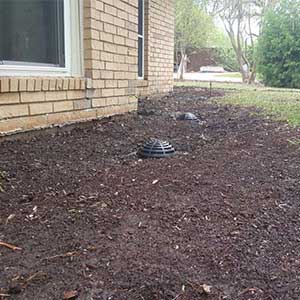Preventing Foundation Problems in Expansive Clay Soil Environments

Expansive Clay: A Tricky Environment
Expansive clay soil environments present unique and challenging conditions for building foundations. The nature of clay soil, with its high plasticity, means it can expand significantly when wet and shrink during dry conditions. This constant change in volume can lead to severe clay foundation problems, including cracking, shifting, and settling of the structure. Understanding how to manage these challenges is essential for long-term foundation health and stability in areas with expansive clay.
Understanding Expansive Clay Soil
Before addressing the prevention of foundation issues, it’s crucial to understand the characteristics of expansive clay soil. Clay soil is made up of fine particles that are highly absorbent, allowing them to swell up to several times their dry size when exposed to moisture. This expansion exerts significant pressure on building foundations. Conversely, as the soil dries, it contracts, sometimes creating gaps beneath foundations, which can cause parts of a building to settle unevenly. The problems in expansive clay environments are exacerbated by external factors such as seasonal weather changes, poor drainage, or inadequate site preparation. This can lead to a cycle of swelling and shrinking that stresses the structural integrity of foundations over time.
Identifying Signs of Foundation Problems
Early detection of potential issues can prevent severe damage and costly repairs. Signs that a building may be experiencing clay foundation problems include:
- Cracks in the foundation itself, walls, or floors.
- Doors or windows that stick or fail to close properly.
- Uneven or sloping floors.
- Gaps around exterior windows or doors.
- Visible changes in the exterior landscape, such as pooling water near the foundation.
Strategies for Preventing Foundation Issues
Preventing foundation problems in expansive clay soil environments requires careful planning, ongoing maintenance, and sometimes engineering solutions. Here are several effective strategies:
Proper Site Selection and Preparation
Choosing the right site and preparing it effectively before construction is fundamental to minimizing future foundation issues. Key steps include:
Soil Testing: Conduct soil tests to understand the specific properties of the clay soil at the site. This information can guide the design of the foundation and preventive measures.
Site Grading: Ensure the site is graded to facilitate proper drainage away from the building foundation. Water should not pool near the foundation, as this can lead to increased soil expansion.
Design and Construction Adaptations
The design and construction of the foundation should be adapted to counter the effects of expansive soils.
Deep Foundations: Using piers or pilings can anchor the foundation deeply enough that the swelling soil does not impact the majority of the foundation structure.
Flexible Foundation Design: Some designs allow for flexibility in the foundation structure to accommodate soil movement without causing damage to the building.
Reinforcing Materials: Incorporating reinforcing materials like steel within the concrete can enhance the foundation’s resistance to the stress caused by swelling soils.
Landscaping and Drainage Solutions
Proper landscaping and effective drainage are critical in managing the moisture content in expansive clay soils.
Drainage Systems: Implementing French drains, surface drains, or other drainage systems helps prevent water from accumulating near the foundation.
Moisture Barrier Installation: Installing moisture barriers around the foundation can reduce the amount of water that penetrates the soil immediately around the building.
Vegetation Management: Certain types of plants and trees can either help maintain moisture balance in the soil or exacerbate foundation problems due to their water needs. It’s important to select and position landscaping elements thoughtfully.
A Sloped Landscape: Arranging your landscape so that the soil slopes downward from your house can effectively channel rainwater away from your foundation. This reduces the amount of water that penetrates the clay-rich soil, minimizing expansion and maintaining a more stable soil environment under your home.
Regular Maintenance and Monitoring
Regular inspection and maintenance can catch and address minor issues before they become major problems.
Routine Inspections: Schedule regular inspections of the foundation and surrounding property to identify signs of movement or stress early.
Moisture Level Monitoring: Keep an eye on soil moisture levels around the foundation, especially during extreme weather conditions. Installation of soil moisture sensors can provide continuous monitoring.
Prevention is Key
Preventing foundation problems in expansive clay soil environments involves understanding the unique properties of clay soil, early detection of potential issues, and implementing specific building and maintenance strategies tailored to these challenges. With the right precautions and proactive measures, it is possible to maintain the integrity and stability of structures built on expansive clay soil, ensuring their longevity and safety.
Dealing with an Expansive Clay? Structured Foundation Repairs Can Help
At Structured Foundation Repairs, trust and integrity form the cornerstone of our service to every homeowner in the Dallas/Fort Worth area. Since our inception in 2003 by Texas A&M graduate Tom Kidd, we’ve evolved from a small team to a top-tier provider of foundation and roofing solutions, underscored by accolades such as the “Aggie 100” and Angie’s List Super Service Award, along with over 34,000 homes repaired. In 2023, we reinforced our commitment to our values by transitioning to an Employee Stock Ownership Plan, making our dedicated staff co-owners treat each home with personal care. Facing foundation concerns? Choose the excellence of Structured Foundation Repairs, where your home is treated like our own. Learn how we can safeguard the durability and safety of your home.
